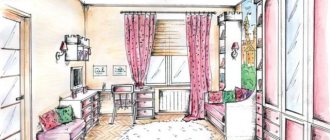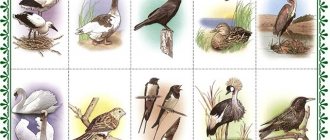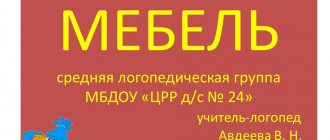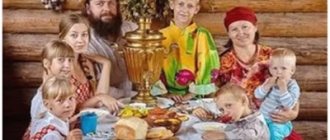NOD "Russian folk sundress"
Summary of an open lesson on artistic creativity using children's design technology:
“Russian folk sundress” (senior group).
Target:
introduce children to Russian folk costume.
Tasks:
— To develop in children the desire to draw a pattern, arranging it rhythmically, to combine colors beautifully, to place the pattern on a given shape, to develop visual attention, to teach how to draw a pattern.
— Continue to develop respect for the traditions of the Russian people, introduce children to the history of Russian clothing, the peculiarities of the appearance of Russian folk costume.
— Continue to introduce ornaments in Russian folk costume.
— Practice the technique of working with a brush: the tip of the bristles, cotton swabs.
— Form aesthetic taste, develop creative imagination.
- Foster love and respect for your homeland.
Preliminary work:
1. Examination of illustrations “Russian folk costume”;
2.N NOD “Russian folk costume”;
3. Conversations on the topic “Clothes of our ancestors.”
4. Didactic game “Dress the doll in Russian folk costume.”
Material and equipment:
contours of the image of a sundress, presentation “Russian folk costume”, brushes, cotton swabs, gouache, rags, samples of embroidery patterns of sundresses, a doll in a Russian folk costume.
NNOD move:
Educator:
Educator: - Guys, let's smile at our friends, all the guests, give everyone the warmth of our smiles and hearts, so that everyone can feel joyful, bright, and comfortable here.
Educator
: Guys, I came to the nursery today and they gave me this. (there is also an address written on it) What is this?
Children's answers: (chest).
Educator: That's right guys, this is a chest in which clothes used to be stored. Let's see what's there. Open the chest, see the letter here.
Educator
: People used to dress differently than we do now.
Dear Guys ! Russian beauties write to you. We wanted to go to the fair, where, according to tradition, girls wear the most elegant, beautiful clothes. And when we took out our sundresses we saw that all the patterns on them had disappeared. Guys, we ask you to help us get to the fair. We will be very grateful to you. Guys, we will help Russian beauties get to the fair.
Children's answers.
(yes we will help)
Educator
: How can we help, return the patterns?
Children's answers
(Draw, cut and paste, embroider, sculpt from plasticine.)
Educator:
Guys, do you think girls used to dress the same way as they do now or differently?
Children's answers:
in another way, their clothes were different and they decorated their clothes with other patterns.
Educator
:I want to show you how Russian beauties used to dress. (presentation) The clothes were loose, long and unusually beautiful. It was sewn from linen fabric.
Aspects of drawing on the topic “Doll in Russian folk costume” in the senior group of preschool educational institutions
Preschoolers try to depict anthropomorphic objects from an early age.
At first these are primitive works according to the principle “Stick, stick, cucumber, here comes the little man!” However, for development to go further, systematic work by the teacher in this direction is necessary. Learning the art of drawing a portrait is inextricably linked with the development of perception and imagination. The teacher must find techniques that will awaken children's interest in the image of a person.
Of course, preschoolers are frightened by the task of drawing a person because they are afraid that they will not succeed. The teacher’s task is to overcome this fear and replace it with a pleasant creative process. It is ideal to start the image not with a human figure, but with something similar to it. So, in the middle level, the guys are happy to draw a matryoshka doll and a snowman. They know well what parts these objects are made of and learn to depict a face. Next, we suggest drawing the Snow Maiden in a wide fur coat and with her hands.
In the older group, a detailed acquaintance with the portrait takes place; children learn the proportions of the face, ways of conveying the character and mood of a person. They draw themselves, parents, friends, fairy-tale characters.
In the preparatory group, children improve their ability to depict anthropomorphic creatures from life and from memory. Children aged 6–7 years are already good at noticing the characteristic features of objects and objects and conveying them in artistic images. At this age, during a drawing lesson, preschoolers are offered such a complex but interesting topic as “A doll in a national costume.” As a rule, this is drawing from life or based on illustrations. Note that the guys are not portraying a person, but a doll. This makes the work a little easier, since the proportions of the body and face structure here will not be so strict: for example, the head can be large, as well as the eyes, mouth, and palms.
When conducting this lesson, the teacher should focus on examining the doll in appropriate clothing. The shape of the sundress (if it is a Russian national costume), shirt, headdress, and shoes is discussed in detail. The teacher also focuses on the location of the arms, legs, and head shape. The doll's head in the picture can be oval or round. To depict a face, children must visually (or with a simple pencil) divide it into three parts: forehead, eyes and nose, lips and chin. The teacher can remind the children how eyes are drawn (draw them on the board), remind them that the nose can only be indicated by its tip (nostrils or a short line).
Sometimes children are offered a schematic drawing of a doll: using a circle (head) and several lines (body parts). This diagram is then outlined with missing elements, including clothing. Another option is to draw with ovals or arcs.
Step-by-step image
In the preparatory group, it is especially important to give children the opportunity to show creative initiative, creative imagination, and encourage their independent choice of color schemes for drawings. So, for example, the guys independently choose the color and pattern of the Russian beauty’s sundress, as well as her kokoshnik. Note that at this age, preschoolers already know a lot of shades, such as lemon, sand, light green, etc.
An important aspect of the preparatory group lesson is the analysis of finished work. By looking at their drawings, children learn to see their strengths and weaknesses. Together with the teacher, the children discuss what can be done better than adding to the composition.
Materials used and base
In the preparatory group, the range of materials with which children can work in the process of visual arts is expanding. Their combination in one drawing helps to create an expressive image. Since the image of a doll in a national costume requires detailed drawing, it is advisable to additionally use felt-tip pens or gel pens when working primarily with paints (watercolor or gouache) or colored pencils. Using these tools, you can designate facial features or intricate patterns on a sundress and kokoshnik.
An image object such as a doll requires a preliminary sketch in pencil.
This is especially true when working with paints. As for the eraser, which is sometimes offered to preschoolers in the preparatory group, it is better not to give it, since children often use it irrationally and spoil the drawing.
As a basis for drawing a doll in a national costume, the teacher offers the children sheets of standard size paper. When painting with paints, they are pre-tinted in pastel colors. By working with colored pencils, children can complete the composition with a suitable background.
Techniques and drawing techniques that should be used when drawing a doll in a national costume in the preparatory group
In the preparatory group, imaging techniques are further improved.
Hand movements become more free and accurate, smooth and rhythmic.
A simple pencil sketch is made with fairly quick hand movements, using a light, unbroken line (to make it easy to correct inaccuracies). By the way, it will be useful if the child completes several test sketches on the draft.
When drawing with a pencil, children practice smoothly turning their hand - this is necessary to depict rounded lines. Preschoolers learn to draw long lines without breaking them and also to depict large shapes. Small details (facial features, patterns on a sundress) are drawn using short lines and strokes.
Similarly, different ways of working with a brush (all bristles and tip) are improved when painting with gouache or watercolor. Preschoolers develop technical skills - they learn to mix paints to create interesting shades.
Additional types of visual activities used when drawing a doll in a national costume in the preparatory group, the relevance of an individual approach
In the preparatory group, the developmental characteristics of children are already clearly visible; some preschoolers have clearly expressed abilities and interest in visual arts. Such children, without a doubt, need to be encouraged, to further stimulate their desire for artistic creativity. One way is to invite them to diversify the composition with additional applicative or plasticine elements.
For example, a sundress or kokoshnik of a Russian beauty can be decorated with plasticine elements (thin ornate flagella or small balls) or shiny sequins can be glued on.
Drawing can be combined with applique, especially if we are talking about a collective composition: the drawn figures of young ladies are painted, cut out, supplemented with applique details and pasted onto the general background.
Drawing with applique elements
Topic: Getting to know Dunyasha's costume. (2nd junior group)
Topic: Getting to know Dunyasha's costume. (2nd junior group)
Goal: to introduce children to Russian folk costume. Continue getting to know the doll Dunyasha. Teach children to choose from a variety of clothes what belongs to Russian folk costume. Through names, bring children to the understanding that people of different nationalities live nearby. Each nation has its own poems, fairy tales, songs, and costumes. Clarify with your children that the best gift to each other is a smile. Develop emotional responsiveness. Continue to teach children to alternate geometric shapes to create a pattern on a strip. Cultivate a friendly attitude towards each other, a desire to help.
Material: Dunyasha doll, set (Russian folk costume) for flannelgraph, box with slots, illustrations for fairy tales, sundress, decorations for the sundress in the form of geometric shapes (red - circle, yellow - square) for each child, game “Assemble a suit” ", audio cassette with Russian folk music.
Preliminary work: excursion to the museum of folk antiquities of the preschool educational institution, acquaintance with Russian folk nursery rhymes, memorizing the nursery rhyme “Grow your braid to the waist.”
Progress of the lesson:
Educator: - Guys, I see from your eyes and smiles that you are in a good mood today. Do you want me to guess why? Because you came to kindergarten and your friends met you here. Did you guess right? Children: - Yes. Educator: - Who are friends? How many friends can there be? Are you guys friendly? -Well done! Look what I have in my hands? (he shows a box with slots in which the picture is visible) - This is a box. Some friend, do you know whose box this is? - That’s right, this is Dunyasha’s box, and a fairy tale is hidden in it. What kind of fairy tale do you think this is? (children look at the picture through the slits) - Well done! This is the fairy tale "Spikelet". This is a Ukrainian folk tale. What Russian folk tales do you know? Why is the fairy tale called a folk tale? -That's right, because it was invented by the people. Tell me, who told us the fairy tale “Spikelet”? Whose favorite fairy tale is this? -Yes, Dunyasha told us this fairy tale when she came to visit us. What do you think, if Dunyasha’s box is here, then where is Dunyasha herself? Should we call her? (knock on the door, the teacher brings the doll to Dunyasha) - Hello Dunyasha. We are very glad to see you. -Guys, Dunya is also very happy to see us all. She liked it so much that she decided to come and visit us today. So that Dunya remembers our names, we will all play the game “What is your name?” (children stand in a circle, but do not hold hands) - I, Olga Pavlovna. I'm Russian. (he takes the hand of the child standing next to him. The children take turns saying their name and nationality, join hands, the last one takes Dunyashi, it turns out to be a circle) - We each have different names and they are all very beautiful. We also differ from each other in that we are of different nationalities, but we are all friends together. We hold hands and the warmth from our hands is transferred to each other, warming us. Now look at each other, smile. Our group became warm, light and joyful. -Sit down on the chairs. Dunyasha brought us something interesting. This is a book, maybe it contains fairy tales? (voice shows the book “Russian folk costume”) - This book tells about Dunyasha’s clothes (voice shows the book to the children) Dunya, since she is Russian, has a Russian folk costume. This is a shirt, it is wide, decorated with a pattern along the edges of the sleeves and at the collar. (show) - Let’s repeat it all together - this is a shirt. -This is a sundress. (show) It is decorated with beautiful braid. Let's repeat the sundress together. -Dunyasha wears a kokoshnik (display) on her head, it is decorated with beautiful beads. Let's repeat - kokoshnik. -On the feet - bast shoes (show) (each time the teacher attaches to the flannelgraph: shirt, sundress, kokoshnik, bast shoes) -All together this is a Russian folk costume. Are you and I now dressing like Dunyasha? We don't dress like that. This is how they dressed before. People of different nationalities live nearby, each nation has its own songs, poems, games, costumes, and fairy tales. -And what a long braid Dunyasha has. Our girls also have braids, and when we comb them, we remember the nursery rhyme “Grow your braids to your waist.” -Dunyasha, do you want to listen to a nursery rhyme? (child reads a nursery rhyme) Grow your braid, don’t lose a hair to your waist. Grow the scarf to the toes, all the hairs in a row. Grow your braid, don’t get confused, listen to Mom Dunya. -Well done! This is the nursery rhyme about the braid that our children know. Did you like it? Our children really want to play with you. Do you want? Then stand in a circle.
Physical education minute. This is such a wonderful house, there are many neighbors in it. Here is a Kazakh, and here is an Avarka, here is a Russian and an Armenian. In this glorious house you need to live very friendly with everyone. Do not offend anyone, respect all neighbors. - Guys, did Dunyasha bring us something else, let’s see what it is? (he shows the bag and takes out a real sundress from it) Dunyasha has a request for us. She was invited to visit, but here’s the problem. She asked to sew a sundress for her, the dressmaker sewed it, but she got sick and did not have time to decorate it. Dunyasha really asks you to help her. Shall we help? -Here is the sundress, the dressmaker only managed to sew on a white ribbon, which is called the prince’s ribbon, it needs to be decorated. Here in the box are the decorations. (shows the children a red circle, a yellow square) Now you and I will decorate the sundress. (he puts the sundress on the girl) -I’ll attach the square first, and then we’ll attach the circle, which shape will I attach next? (square) (children alternately attach a circle, a square, which are attached to the white tape with Velcro) - Now you and I will sit on the chairs and see how great we are, how we decorated the sundress. (the teacher asks the girl in a sundress: spin around, show us how beautiful and elegant the sundress has become). Do you think Dunyasha can go visit now? (he takes off the sundress from the girl and gives it to Dunyasha) - How did you and I help Dunyasha? Dunya says “Thank you” to us. We are so great! We are real friends, we helped together so much. -Are you glad that you helped Dunya? -For our help, Dunya brought us a gift (he shows the children the box) This is the game “Assemble Dunyasha’s costume.” -Today we got acquainted with Russian folk costume. So we can play this game. -This concludes our lesson. I am very pleased with you, you are great!
Get text





